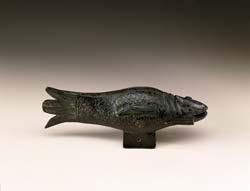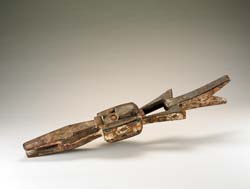
From the Akan peoples to the Yoruba to the Benin kingdom, there is a fish--commonly called the mudfish--that is both mythical and real. In art and oral literature, the mudfish combines the traits of several species of fish and is an icon of wealth and the divine powers of rulers. The real fish lives when others would die-either by crawling on land or burying itself in the mud of the streambed. Some of the fish also have a dangerous electric charge, which one might equate with the ruler's power as a judge. Picture a combination of a catfish and an electric eel. Often smoked on sticks, the fish can be purchased in the market to be eaten or used as a sacrificial offering.
Masquerades representing waterspirits are popular among the art-producing groups of Nigeria's Niger Delta region. Though playful, mischievous and linked with the wilderness, Niger Delta waterspirits are generally considered more benevolent, kind and beautiful than other denizens of the wild that inhabit dry land. Each waterspirit of the Kalabari Ijo peoples has its own festival, part of a cycle of periodic festivals. Waterspirit masks take a variety of forms, either singly or in combination with the hippopotamus, crocodile, swordfish, shark, smaller fish, and python as well as human forms (2005-6-137).
Land snails do not live in the water but act as containers that hold materials or medicines associated with the water's spiritual or abstract qualities, including coolness, control and serenity.

Display object
Akan peoples, Côte d'Ivoire
Early to mid-20th century
Snail shell, lead tin alloy
Gift of Philip L. Ravenhill in memory of Sylvia H. Williams, 96-42-4
|

Figure of a mudfish
Benin kingdom court style, Edo peoples, Nigeria
Mid-16th century
Copper alloy, copper
Gift of Joseph H. Hirshhorn to the Smithsonian Institution in 1966, 85-19-8
|

Waterspirit mask
Ijo peoples, Nigeria
Mid-20th century
Wood, pigment, iron, plant fiber
Gift of Walt Disney World Co., a subsidiary of The Walt Disney Company,
2005-6-137
|
|
|
|